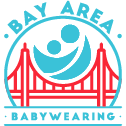
While I was in Atlanta attending IBC, I went to a session about the Biomechanics of Babywearing (1), given by Kat Sniffen of Greater Boston. It just so happens that my background is in biomedical and mechanical engineering, so I found the session fascinating and wanted to bring what I learned back to share with our group.
Kat discussed some of the concerns associated with babywearing and whether they were fact or fiction using biomechanics (2), or mechanical principles as they apply to the human body. As educators, we often hear a lot of these concerns when helping families with babywearing and Kat’s session helped me better understand the reasoning behind our practices. I hope that this summary of her presentation helps you as well!
Concern 1: Wearing your baby facing out or in a narrow-based carrier causes hip dysplasia (deformation or misalignment of the hip socket (3)) while ergonomic carriers can prevent or treat hip dysplasia.
Facts: Wearing your baby for a limited amount of time per day (less than 3 hours) with their legs dangling facing out or in a narrow-based carrier does not cause hip dysplasia, but can exacerbate an already existing condition. In a Japanese study, after a campaign to eliminate tight swaddling with legs straight (which is similar to allowing baby’s legs to dangle in a carrier and cradle carry position), there was a more than 90% reduction of in the incidence of hip dislocation, which occurs when the femur is not well-seated in the hip socket and can be an indication of hip dysplasia (4).
Putting babies in a position where their thighs are supported and the carrier extends from knee to knee, as occurs with an ergonomic carrier, does encourage deep-seating of the femur into the hip socket, which is beneficial for healthy hip development (5)

My dad and oldest daughter in an ergonomically designed SSC.
Concern 2: Knee to knee support matters less after age 2.

Facts: Growth potential of the hip
steadily decreases after birth and the
development ceases as early as 18 months and as late as 3 years.
However, proper leg support is not only important for proper hip
development but also for maintaining
a seat in a wrap or sling, spreading
weight across the back and hips
and reducing pressure on the
baby/child’s legs, increasing their
comfort.
Concern 3: My one-year old needs a toddler carrier.
Facts: It turns out that most toddler carriers are not actually designed for toddler- sized children. For example, a Toddler Tula is 19” wide, but the average toddler’s knee to knee width is 17”. Using a carrier that is too wide can force the child’s hips to be spread too wide and not allow their lower legs to move freely.

This carrier is too wide for this child!
Concern 4: Babywearing can replace tummy time.
Facts: Babywearing does help and prevent positional plagiocephaly (or flat head syndrome) and does help strengthen baby’s upper body muscles. However, baby is pushing perpendicular to gravity when being worn, rather than directly against it when on the floor, which is necessary to strengthen baby’s shoulder muscles.

Concern 5: Wearing baby facing out is inherently less comfortable than wearing baby facing in.
Facts: Wearing baby facing out is ergonomically less comfortable for the
wearer since, instead of hugging the wearer’s body, baby is leaning away from the
wearer, causing more pull on the wearer’s body. There is less contact between the wearer and baby as well, which places more pressure on the wearer’s shoulders. Over tightening the carrier can increase the contact between the wearer’s and the baby’s bodies, but can force baby’s spine into an unnatural position. Additionally, if the baby’s legs are not in a flexed position, the carry does not promote healthy hip development and if baby falls asleep or has poor head control, there is a risk of positional asphyxia.
Some of these issues can be mitigated with careful carrier design and use, which allows for the benefits of forward facing (such as socialization and visual exposure) with less of the drawbacks.

The Ergo 360 is an example of an ergonomically designed front facing out carrier. Photo courtesy of ErgoBaby.
Concern 6: Footed pajamas make it difficult to get a good seat.

Facts: When a baby’s hips and legs are flexed or bent, the cloth of their pants gathers around their knees. In loose pants, this creates a gap at the ankle, while in footed pajamas, it pulls up on the baby’s feet. In infants, this will trigger a stepping reflex—baby will attempt to “walk” as if they were standing on a flat surface and will extend and bring their legs together. This makes it difficult to keep the knees in “M” position and make a good seat.
Concern 7: One-shouldered carries can hurt your back.
Facts: Force on only one shoulder creates more work for the wearer to stay balanced and upright and forces the spine into misalignment. Spreading the fabric
increases the contact area across wearer’s back, shoulder and front, which helps to spread the weight across the body. Tightening the carrier keeps baby’s weight against wearer’s body, which decreases pressure on the shoulder. Alternating shoulders can help by working different muscle groups, but will not help as much as spreading the fabric and proper tightening.

Look Ma! No hands! No pain!
I hope you found this post helpful and educational. I know I certainly found Kat’s presentation very fascinating!
-
Sniffen, Katherine. “Biomechanics of Babywearing.” International Babywearing Conference. 15 July 2016, Cobb Galleria Conference Center, Atlanta, GA.
-
https://en.wikipedia.org/wiki/Biomechanics
-
https://en.wikipedia.org/wiki/Hip_dysplasia
-
Yamamuro, T., Ishida K, Recent advances in the prevention, early diagnosis, and treatment of congenital dislocation of the hip in Japan. Clin. Orthop. Rel. Res., 1984. 184: p. 34-40.
-
http://hipdysplasia.org/baby-wearing/











Recent Comments